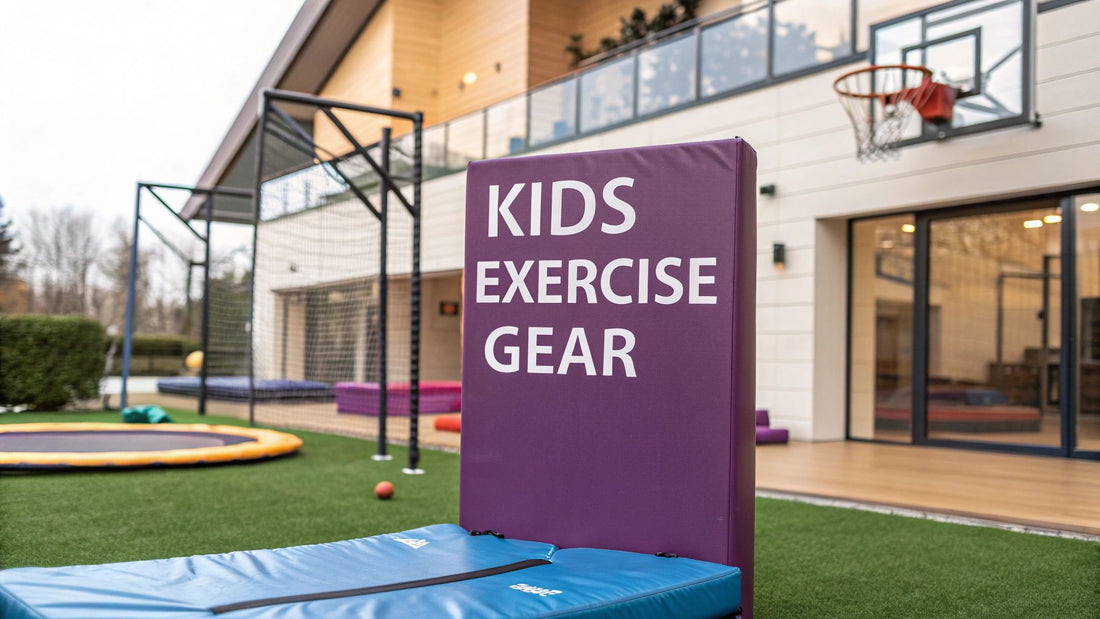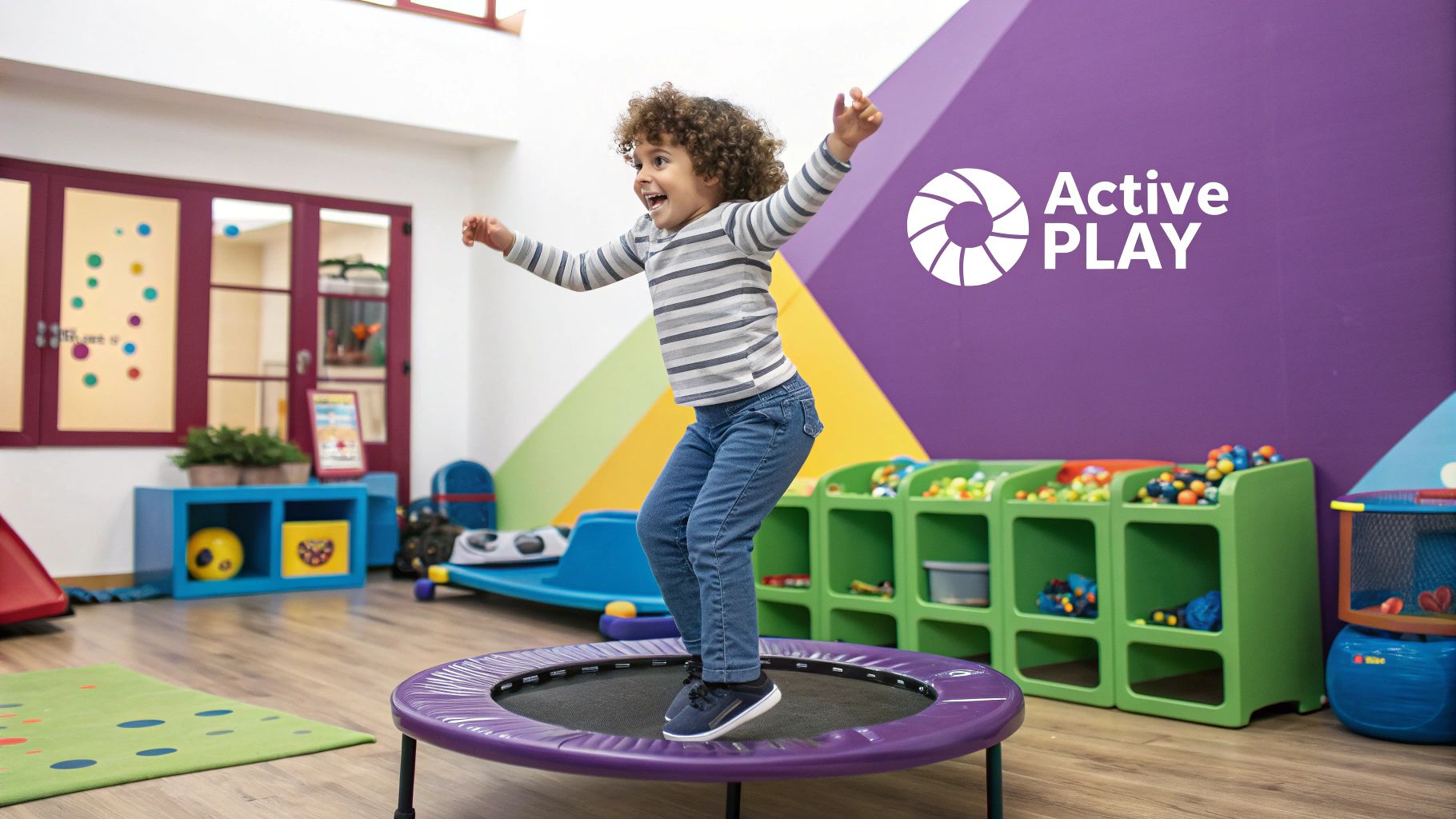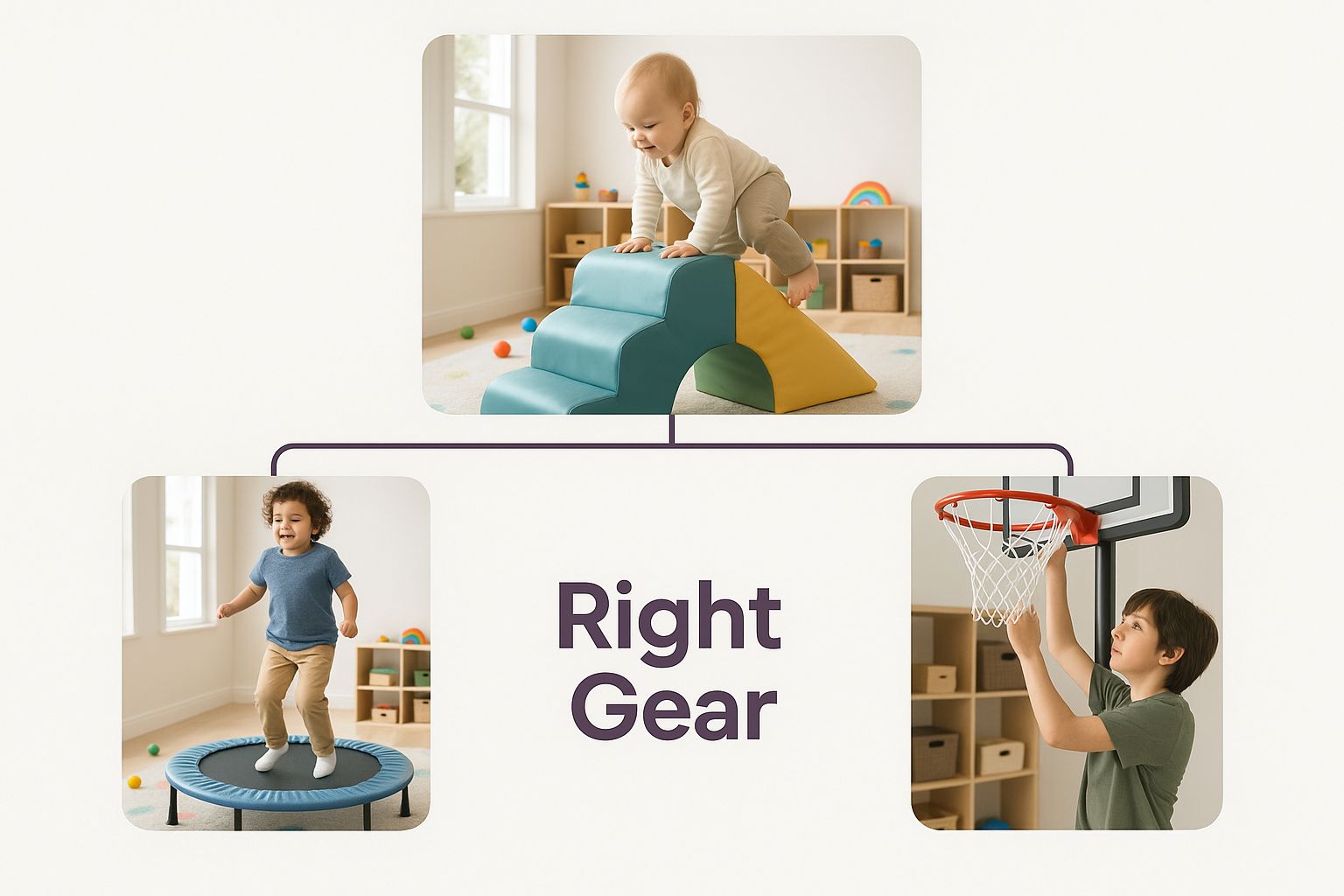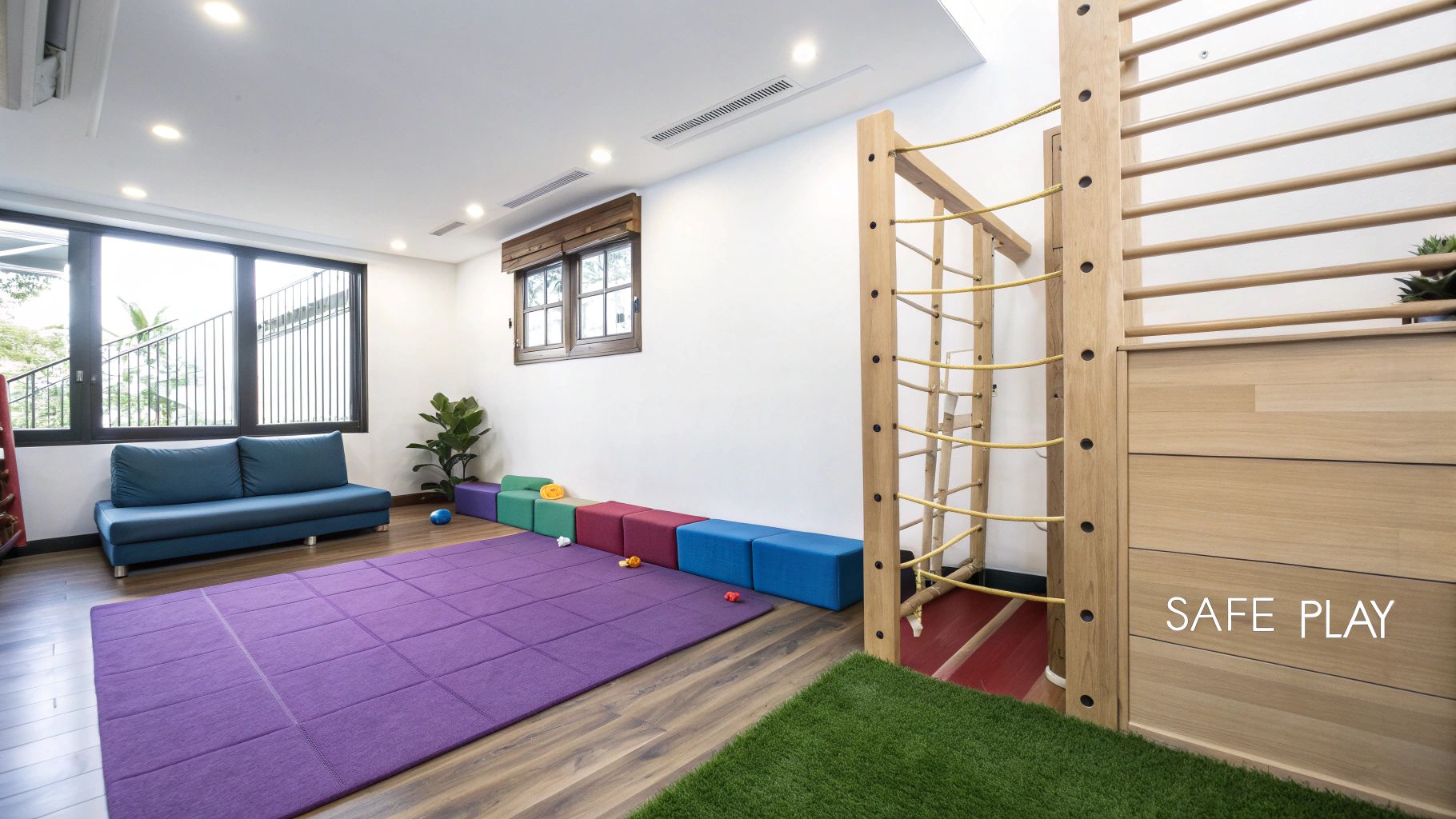
Your Guide to Exercise Equipment for Children
The right exercise equipment for children isn't about reps and sets. It's about turning physical activity into pure, unadulterated fun. It’s about play-based movement that helps kids build strong muscles, sharpen coordination, and fall in love with being active.
Building Healthy Habits in a Digital Age
Let's face it: screens are everywhere. In a world full of digital distractions, getting kids to move their bodies is more critical than ever. The goal isn't to build a miniature gym in your living room. Instead, it's about providing awesome tools that make being active feel like an adventure.
The right gear can spark a child's imagination, transforming a simple room into a universe of possibilities.

When movement is fun, it stops being a chore and starts becoming a habit. This is how we shift kids away from too much screen time toward developing crucial physical and mental skills. A simple climbing triangle, for example, is a confidence-booster and a balance-builder all in one.
The Power of Playful Fitness
Think of it like this: exercise is the engine, and nutritious food is the high-octane fuel that makes it run smoothly.
When you combine joyful movement with smart eating, you’re laying down a powerful foundation for a lifetime of well-being. It's a one-two punch that sets kids on a path to a healthy, happy life.
This idea is catching on. In 2023, the global market for children's fitness equipment was valued at a cool $1.5 billion. Experts project it will more than double to $3.2 billion by 2032. This explosive growth shows a huge shift, as more parents realize the value of active play.
By weaving physical activity into their daily lives, we're teaching kids that taking care of their bodies is a normal, enjoyable part of being alive. It’s about building habits that will stick with them long after they’ve outgrown their first tricycle.
Turning Activity into an Adventure
The secret to keeping kids hooked? Variety and imagination. Forget structured, boring workouts. Think like a kid and turn everything into a game.
An obstacle course built from cones and soft play mats can deliver hours of entertainment while improving agility and coordination. For more ideas, check out our guide on fun exercise games for kids.
This approach nurtures a positive relationship with physical activity. When kids connect movement with laughter and fun, they’ll seek it out on their own. That’s the real win—building strong bodies and confident minds.
How to Choose the Right Equipment for Every Age
Picking out exercise equipment for a child is about matching the gear to their developmental stage. The goal is to find something that offers a fun challenge, building skills and confidence without being overwhelming.
When you match the gear to the right age, kids are more likely to stay engaged and avoid injury. This infographic breaks it down visually.

As you can see, the equipment progresses from soft toys for little ones to more dynamic, skill-based gear for older kids. This creates a logical path for their physical development.
To make this even easier, here's a quick reference table that breaks down the best equipment for each age group and what it helps them develop.
Age-Appropriate Exercise Equipment Guide
| Age Group | Recommended Equipment Types | Key Developmental Benefits |
|---|---|---|
| Toddlers (2-4) | Soft play sets, small climbers, ride-on toys, low balance beams. | Gross motor skills, balance, coordination, body awareness. |
| Young Children (5-8) | Mini trampolines, junior boxing sets, hula hoops, jump ropes, scooters. | Cardiovascular health, agility, hand-eye coordination, energy release. |
| Pre-Teens (9-12) | Adjustable basketball hoops, portable soccer goals, beginner yoga mats, resistance bands. | Sport-specific skills, strategic thinking, strength, flexibility, focus. |
This table is a great starting point, but let’s dive a little deeper into what makes each stage unique and what kind of gear really shines.
Toddlers (Ages 2-4) Building the Basics
For toddlers, the world is a playground. Their main job is mastering gross motor skills—those big movements using their arms, legs, and torso. The best equipment for them is simple, safe, and sparks their curiosity.
Things like soft play sets, small climbers, and low balance beams are perfect. They give toddlers a safe space to climb, crawl, and test their balance without serious risks. These activities are crucial for developing body awareness and coordination.
Of course, all that movement requires fuel. Simple, nutrient-packed snacks like mashed avocado or yogurt with berries provide the sustained energy they need to keep exploring.
Young Children (Ages 5-8) Unleashing Energy
Once kids hit this age, their energy levels explode. They’re ready for more dynamic play that can challenge their growing agility and endurance.
Mini trampolines are a huge hit. They’re amazing for cardiovascular health and feel like pure fun. A junior boxing set is another fantastic option for getting pent-up energy out and improving hand-eye coordination.
Our Junior Punching Bag is designed just for this age, offering a safe and super engaging outlet for active kids.
It’s so important to pair this high-energy activity with the right nutrition. After a bouncing session, a simple snack like apple slices with peanut butter is perfect for replenishing their energy stores and helping their muscles recover.
Pre-Teens (Ages 9-12) Honing Skills
By their pre-teen years, most kids have better control over their bodies. They're ready for more skill-based activities that mimic real sports, which helps them develop specific talents and an appreciation for practice.
Adjustable basketball hoops or portable soccer goals are excellent choices. They grow with your child, providing a perfect setup for practicing shots and learning strategy. This play builds physical skills and teaches persistence.
This is also the age to talk about the connection between food and performance. For a deeper dive into fueling young athletes, check out the Diet & Exercise YouTube channel. It’s packed with great, practical nutritional tips for active families.
The Real Payoff of Kids' Fitness Gear
The right exercise equipment for children delivers incredible developmental perks. It's about giving them fun tools that help build a stronger, smarter, and more confident kid. The benefits spill over into every part of their lives.
When kids get equipment made for them, they're laying the groundwork for physical literacy and a healthy attitude toward movement.
Sharpening Motor Skills and Coordination
Every time a child climbs or balances, their brain and body are having a high-speed conversation. This sharpens their gross motor skills—those big movements using their arms, legs, and core.
Better coordination helps with everyday things, like tying shoes or navigating a crowded hallway. When kids feel in control of their bodies, they walk with more confidence into social and academic situations.
Building Strong Bones and Muscles
Childhood is the most critical window for building bone density. Weight-bearing activities like jumping or swinging put productive stress on their bones, signaling them to grow stronger.
You can think of an active childhood as making deposits into a "bone bank." The more they move now, the lower their risk for issues like osteoporosis down the road. Combine that with a diet rich in calcium, and you've got the perfect recipe for a rock-solid skeleton.
Boosting Confidence and Self-Esteem
Picture a kid's face the moment they nail a new skill. That "I did it!" moment is gold for their self-esteem. Fitness gear offers a safe environment to set tiny goals and feel the rush of achieving them.
Our Junior Punching Bag is a great example. It’s more than a way to let off steam; it teaches focus and control. Every solid punch is a small win, building their belief in what they can do. This confidence follows them into the classroom and onto the playground.
Improving Focus and Brain Function
The link between a moving body and a thinking brain is undeniable. When kids get active, it pumps more blood to the brain. This can lead to better focus, a stronger memory, and sharper problem-solving abilities.
If you're curious to learn more about how exercise fuels the brain, the Diet & Exercise YouTube channel has fantastic videos on the topic. A quick, fun play session can prime a child's mind for learning.
Creating a Safe and Inspiring Home Play Zone
Setting aside a specific spot for play is one of the best ways to get kids moving regularly. But first, you have to get the safety right. A secure and inviting space gives kids the confidence to explore and push their boundaries safely.
This is about taking a few smart, simple steps to prevent bumps and tumbles. A little planning can transform an ordinary space into an exciting arena for adventure.

The real goal is to create an environment where a kid can just be a kid—and you don't have to worry.
The Foundation: Flooring and Space
The most critical part of any safe play area is what’s under their feet. A fall on a hard surface can turn a minor slip into a major ouch. This is where impact-absorbing flooring is your best friend.
Interlocking foam tiles are a fantastic choice for indoor areas. They piece together easily to create a soft surface that's perfect for everything from tumbles to gymnastics practice.
Once the floor is covered, think about the space itself. A classic mistake is cramming too much gear into a small area.
We call this the "safe fall zone"—the clear, open space you need around any piece of equipment. As a rule of thumb, aim for at least six feet of clearance on all sides of things like mini-trampolines or climbing structures.
This one guideline alone drastically cuts down on accidents.
Smart Equipment Choices and Regular Check-Ups
With your space prepped, it's time to think about the gear. When shopping for exercise equipment for children, look for items with rounded corners, stable bases, and no small parts that could be a choking hazard.
Quality materials make a big difference. For instance, a good foundation like our soft but sturdy Kids Interlocking Play Mat is designed to absorb impact, creating an ideal base for any active play.
A safe play zone needs ongoing attention. Do a quick safety audit once a month.
- Check for Stability: Give climbing structures a good shake. Do they wobble? Everything should feel solid.
- Inspect Surfaces: Run your hands over the equipment. Are there any splinters, sharp edges, or cracks?
- Tighten Hardware: Check that all nuts, bolts, and screws are still tight.
This maintenance ensures the play zone stays safe. Don't forget to fuel all that activity! For great ideas on combining fitness and food, check out this helpful video from the Diet & Exercise YouTube channel.
Our Top Picks for Kids' Fitness Gear
You've carved out a safe space. Now for the fun part—picking out the gear! The best exercise equipment for children solves a real need, whether it's helping a toddler burn off energy or giving a pre-teen a way to master new skills.
We've rounded up a few of our favorites. These pieces blend effective physical development with pure, simple fun. Each is designed to adapt as your child grows, giving you lasting value.
For Mastering Gross Motor Skills: The Indoor Climbing Triangle
Toddlers are born climbers. Giving them a safe outlet for that instinct is key to building their gross motor skills, balance, and confidence. An indoor climber is a game-changer.
The Indoor Climbing Triangle is the perfect first mountain for little explorers. Its gentle slope and sturdy rungs offer a secure way to practice climbing. As they pull themselves up and down, they’re strengthening core muscles and sharpening coordination.
This climber is a powerhouse for developing body awareness. It teaches kids how to plan their movements and understand where they are in space—foundational skills for everything from sports to the playground.
This piece isn't just about climbing; it’s a confidence-building machine. Every time they reach the top, it’s a little victory that boosts their self-esteem.
For Hand-Eye Coordination and Social Play: The Kids Adjustable Basketball Hoop
As kids get older, their play becomes more social and skill-based. Equipment that gets them playing together while they work on hand-eye coordination is a huge win.
The Kids Adjustable Basketball Hoop is a classic for a reason. It’s an effective tool for teaching kids how to aim, throw, and track a moving object. Trying to sink a basket refines their motor skills in a way that feels like a game.
Plus, you can change the height. This means it grows with your child, offering the right challenge from their toddler years into their pre-teen phase. You can find a great option on our Kids Adjustable Basketball Hoop product page. That versatility ensures it’ll be a favorite for years.
For Energy Release and Focus: The Junior Boxing Set
Some days, kids just have a ton of energy. A junior boxing set is a fantastic solution. It channels that energy into a focused activity that builds strength, coordination, and even discipline.
Our Junior Boxing Set gives kids a safe way to boost cardiovascular health and improve hand-eye coordination. It also teaches control and focus. Learning to land a punch on the bag takes concentration, helping them channel energy with purpose.
This physical activity goes hand-in-hand with a healthy diet. Fueling them with nutritious snacks before a session gives them energy to play hard. For kid-friendly ideas, the Diet & Exercise YouTube channel has tons of simple recipes. The market for this gear is booming, and you can learn more about the children's fitness equipment market leaders and their offerings to see how much this space has grown.
Fueling Active Bodies with Healthy Foods
All that activity needs high-quality fuel. Pairing fun movement on exercise equipment for children with good food creates a powerful combination for healthy growth.
This isn't about strict diets. It's about building simple, positive habits that give kids the energy they need for their next adventure.
Power-Up Snacks Before Play
Before your child dashes off to play, a small snack can make all the difference. Think of "power-up" snacks that offer quick energy without feeling sluggish. The key is easily digestible carbohydrates.
A few great choices include:
- A small banana
- Apple slices with a bit of nut butter
- A handful of whole-grain crackers
These are simple, easy, and give them the get-up-and-go they need. This support is more important than ever. As the market for children's fitness equipment grows in response to health concerns—the WHO reports 39 million children are obese—the need for active solutions and smart nutrition has skyrocketed. You can learn more about the growing fitness equipment market and see how big this trend has become.
Recovery Boosts After Fun
Once playing is done, a child's body needs to refuel. "Recovery boosts" combine protein and carbohydrates to recharge tired muscles. A healthy breakfast is a huge part of this, setting the stage for an energetic day. For morning meal ideas, check out our guide on healthy breakfast ideas for kids.
Good post-play nutrition ensures they're ready for more fun tomorrow.
Think of post-activity nutrition as rebuilding with LEGOs. Protein helps repair the muscle "bricks," and carbs restock the energy bin they just emptied out.
Some excellent recovery options are:
- Yogurt with berries and a sprinkle of granola
- A small fruit smoothie made with milk or a plant-based alternative
- A glass of low-fat chocolate milk (a surprisingly perfect mix!)
By pairing energetic play with smart nutrition, you're teaching them a powerful lesson about listening to their bodies.
Answering Your Top Questions About Kids' Exercise Equipment
When it comes to exercise equipment for children, it's normal to have questions. Let's tackle some of the most common ones.
What’s the Right Age to Start?
You can start introducing kids to age-appropriate gear as toddlers. For the 2-4 age group, think soft play items, foam blocks, and low climbers. This isn't "working out"; it's about building foundational motor skills through play.
As they get older, bring in things with more action, like mini trampolines. Always match the equipment to their developmental stage.
Is It Better to Get Indoor or Outdoor Equipment?
Honestly, both have unique benefits. Outdoor gear like a swing set is fantastic for big movements and getting fresh air.
Indoor equipment, like a gymnastics mat, is your secret weapon against rainy days. The perfect setup? A little of both! If you're short on space, look for versatile indoor pieces that are easy to put away.
How Do I Get My Kid Motivated to Be Active?
The magic word is fun. If it feels like a chore, they won't do it. The best way to get them excited is to jump in with them. Set up a silly obstacle course or make up a friendly family challenge.
Tapping into what they already love is key. If your child is a natural climber, a play structure will be a huge hit. A stationary bike? Probably not. Keeping things fresh will keep them engaged.
Good energy starts with good food. For tips on fueling your active kids, the Diet & Exercise YouTube channel has excellent, family-friendly advice. The right nutrition gives them the power they need for play.
Ready to build a space where your kids can move, play, and grow? Check out the full collection of kid-friendly fitness gear and accessories at Diet and Exercise. Visit us today at https://dietexerciseshop.com to find the perfect tools to get your family moving
